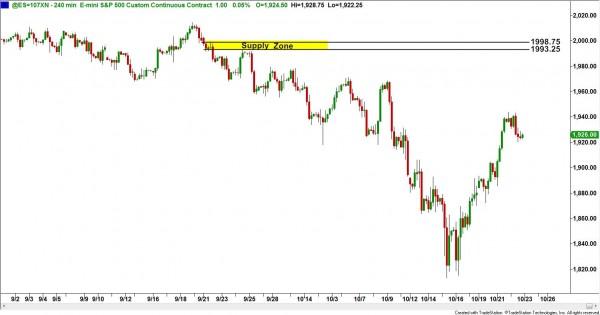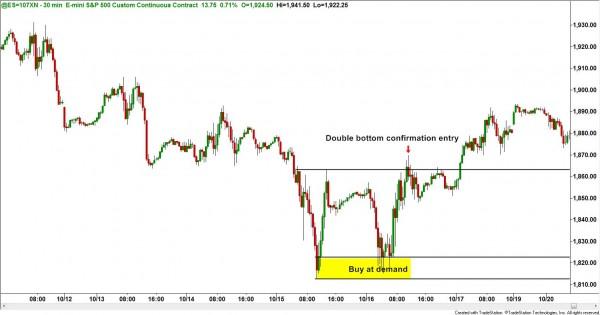In the world of trading, the people that usually profit are those that learn how to anticipate when the market will turn, versus those that follow, and usually get in late. The primary cause traders join a move after it has already run its course is that the indicators they use to trigger their buy or sell signals are always lagging price. By this I mean that since most traders use conventional technical indicators (which calculate price in the past to plot a line or oscillator) to trade, they will always generate buy or sell triggers after price has turned. As a result, they will never give a trader the lowest risk entry point. The lowest risk entry points are always found at the market turning points, not after the move is already underway.
In addition to the indicators used by most, the patterns used by the masses always need “confirmation” to trigger buy or sell signals. Again, this means that the move is always underway before they buy or sell. For the majority of traders this gives the illusion that it is safer to buy after a confirmation move has taken place, but reality is that when price is moving fast into a supply or demand zone the risk is actually very high, and the reward is very low.
A recent example of this happened over the last two weeks as the stock market sold off sharply and then swiftly reversed. One of the most common indicators traders and investors use to gauge a trend is a moving average. Specifically, the 200 day moving average is used by the multitudes to identify whether stocks are in a bull or bear market. Simply, if price is trading above the moving average the market is bullish and if we close below that average traders are told to sell because this implies a bear phase is starting. The one challenge with this strategy is that if you sell after price has violated the 200 day moving average you are always selling after the market has dropped ten or fifteen percent from its peak.
Instead, selling near the highs can be accomplished by identifying where the institutions are selling ( supply). As we can see from the charts below a trader/investor would have taken lower risk anticipating where the market had a high probability of selling off rather than waiting for a sell signal from price crossing below the moving average.
So when the market finally bottomed and turned up furiously , this same approach suggests that an investor wait until the moving average is crossed to the upside. As we can see that also does not avail a trader to capture a low risk entry.
Another common pattern the traders who use conventional patterns to identify when a market may be headed higher is a double bottom. The pattern simple looks like the letter “W.” The chart below shows that indeed we did form a “double bottom” and then turned up. The setup in this pattern is to wait for a break above the apex of the “W” before buying. The challenge here as seen on the chart is that a trader would have had to suffer through roughly a 15 point pullback before the S&P 500 resumed the upward move.
As an alternative, a trader would have taken a lower risk entry by buying at the demand zone highlighted in the chart.
Finally, the objective of this article is to get you thinking about the tools you’re using to engage the markets. Are they lagging? Or are they leading (anticipatory)? And contrary to what everyone thinks, yes, you can anticipate market turns before they happen. Provided you learn how the markets really works.
Until next time, I hope everyone has a wonderful week.
This content is intended to provide educational information only. This information should not be construed as individual or customized legal, tax, financial or investment services. As each individual's situation is unique, a qualified professional should be consulted before making legal, tax, financial and investment decisions. The educational information provided in this article does not comprise any course or a part of any course that may be used as an educational credit for any certification purpose and will not prepare any User to be accredited for any licenses in any industry and will not prepare any User to get a job. Reproduced by permission from OTAcademy.com click here for Terms of Use: https://www.otacademy.com/about/terms
Editors’ Picks
EUR/USD edges lower toward 1.0700 post-US PCE

EUR/USD stays under modest bearish pressure but manages to hold above 1.0700 in the American session on Friday. The US Dollar (USD) gathers strength against its rivals after the stronger-than-forecast PCE inflation data, not allowing the pair to gain traction.
GBP/USD retreats to 1.2500 on renewed USD strength

GBP/USD lost its traction and turned negative on the day near 1.2500. Following the stronger-than-expected PCE inflation readings from the US, the USD stays resilient and makes it difficult for the pair to gather recovery momentum.
Gold struggles to hold above $2,350 following US inflation

Gold turned south and declined toward $2,340, erasing a large portion of its daily gains, as the USD benefited from PCE inflation data. The benchmark 10-year US yield, however, stays in negative territory and helps XAU/USD limit its losses.
Bitcoin Weekly Forecast: BTC’s next breakout could propel it to $80,000 Premium

Bitcoin’s recent price consolidation could be nearing its end as technical indicators and on-chain metrics suggest a potential upward breakout. However, this move would not be straightforward and could punish impatient investors.
Week ahead – Hawkish risk as Fed and NFP on tap, Eurozone data eyed too

Fed meets on Wednesday as US inflation stays elevated. Will Friday’s jobs report bring relief or more angst for the markets? Eurozone flash GDP and CPI numbers in focus for the Euro.
RECOMMENDED LESSONS
Making money in forex is easy if you know how the bankers trade!
Discover how to make money in forex is easy if you know how the bankers trade!
5 Forex News Events You Need To Know
In the fast moving world of currency markets, it is extremely important for new traders to know the list of important forex news...
Top 10 Chart Patterns Every Trader Should Know
Chart patterns are one of the most effective trading tools for a trader. They are pure price-action, and form on the basis of underlying buying and...
7 Ways to Avoid Forex Scams
The forex industry is recently seeing more and more scams. Here are 7 ways to avoid losing your money in such scams: Forex scams are becoming frequent. Michael Greenberg reports on luxurious expenses, including a submarine bought from the money taken from forex traders. Here’s another report of a forex fraud. So, how can we avoid falling in such forex scams?
What Are the 10 Fatal Mistakes Traders Make
Trading is exciting. Trading is hard. Trading is extremely hard. Some say that it takes more than 10,000 hours to master. Others believe that trading is the way to quick riches. They might be both wrong. What is important to know that no matter how experienced you are, mistakes will be part of the trading process.


